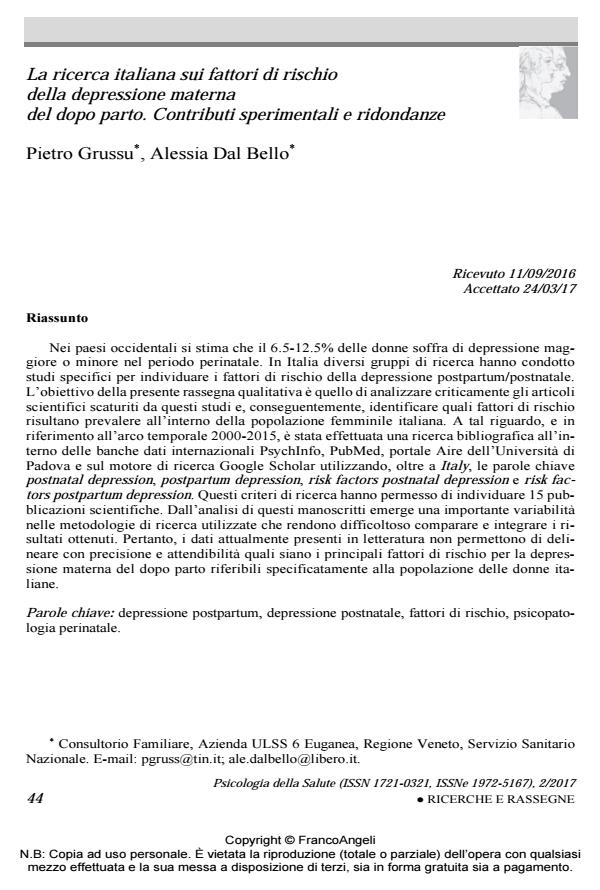Risk factors of maternal depression after childbirth in Italian research. Significant contribu-tions and redundant results
Journal title PSICOLOGIA DELLA SALUTE
Author/s Pietro Grussu, Alessia Dal Bello
Publishing Year 2017 Issue 2017/2
Language Italian Pages 26 P. 44-69 File size 269 KB
DOI 10.3280/PDS2017-002003
DOI is like a bar code for intellectual property: to have more infomation
click here
Below, you can see the article first page
If you want to buy this article in PDF format, you can do it, following the instructions to buy download credits

FrancoAngeli is member of Publishers International Linking Association, Inc (PILA), a not-for-profit association which run the CrossRef service enabling links to and from online scholarly content.
In Western countries, approximately 6.5-12.5% of women suffer from minor or major depression in perinatal period. In Italy, various research groups have conducted studies specifically to identify the risk factors of postnatal/postpartum depression. The objective of this qualitative review is critically analyze the scientific articles resulting from these studies. Consequently, to identify what risk factors are to prevail in the Italian female population. To that end, bibliographic research was conducted using the Google Scholar search engine and within the international databanks 2000-2015 of PsychInfo, PubMed and the AIRE website of the University of Padua which provides access to the school’s Digital Library System. In addition to "Italy", the following key words and phrases were also searched: "postnatal depression", "postpartum depression", "risk factors postnatal depression" and "risk factors postpartum depression". These research criteria led to the identification of 15 scientific publications. From the analysis of these manuscripts it becomes apparent that the varied research methods used by the different research groups make it difficult to compare and integrate the results. Therefore the data currently available in the literature do not lead to a precise and reliable determination of the principal risk factors for maternal depression after childbirth in Italian women.
Keywords: Postpartum depression, postnatal depression, risk factors, perinatal psychopatholo-gy.
- Perinatal mental health around the world: priorities for research and service development in Italy Pietro Grussu, Ilaria Lega, Rosa Maria Quatraro, Serena Donati, in BJPsych International /2020 pp.8
DOI: 10.1192/bji.2019.31
Pietro Grussu, Alessia Dal Bello, La ricerca italiana sui fattori di rischio della depressione materna del dopo parto. Contributi sperimentali e ridondanze in "PSICOLOGIA DELLA SALUTE" 2/2017, pp 44-69, DOI: 10.3280/PDS2017-002003